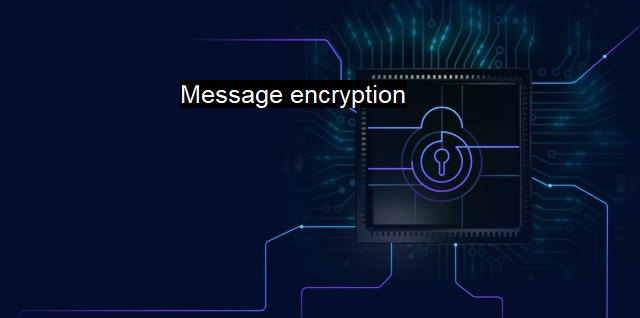What is Message encryption?
The Importance of Message Encryption in Cybersecurity: Protecting Confidential Data from Malware Attacks
Message encryption is a pivotal concept in the sphere of cybersecurity that pertains to the conversion of readable plain text into an absorbed and cover-up cryptic text. it's a key mechanism used to prevent unauthorized access to information, protecting it from corruption and loss. Its significance in cybersecurity continues to evolve due to an increasingly digital and interconnected world, populated with cyber threats.Message encryption transforms data into a coded format. This makes it impossible for unauthorized entities or individuals to tamper with it or understand it unless they possess the correct key to decode it. Effective message encryption must qualify both confidentiality, meaning it cannot be accessed without the correct decryption key, and data integrity, where it's assured that the data hasn't been tampered with during transmission.
The heart of message encryption lies in the encryption algorithm, which makes the data unreadable while it's being transmitted. This encryption algorithm uses a 'key' that enables breaking the code. Two types of these keys are the symmetric key (Private Key) or the asymmetric key (Public Key) encryption, with each boasting its own relative strengths and limitations.
Symmetric key encryption uses the same key for encrypting and decrypting the message. It is faster and more efficient, making it suitable for large quantities of data. its downside currently lies in its difficulty in key management since both the sender and receiver must have the same key, raising concerns associated with the key's distribution and storage.
On the contrary, asymmetric key encryption uses one public key to encrypt a message and a private key to decrypt it. Ideal for secure key distribution and digital signatures, it makes it virtually impossible for someone to decrypt the key without the private key. the process is slower and requires more computational resources, making it less feasible for big quantities of data.
Message encryption has a robust application in cybersecurity. For instance, in antivirus software, encryption plays a significant role. Antivirus uses message encryption to secure the integrity of virus definitions updates and new version releases to ensure that the end-users receive the authenticated and original version of the application. This curbs the risk of rogue software or malware disguised as a 'hole' in the code base that could corrupt or compromise the wider system.
Various cybersecurity protocols in businesses and organizations adopt message encryption to protect sensitive data during transmission. This includes information related to financial transactions such as banking details, corporate secrets, personal employee data, among other critical pieces of information.
It's important also to consider the encryption standards set by cybersecurity governance bodies like the National Institute of Standards and Technology (NIST). Following these standards ensures that organizations are employing robust encryption mechanisms to secure their message transmissions.
The increasing reliance on digital communication emphasized by the COVID-19 pandemic has intensified encryption's necessity. though message encryption remains one of the most effective ways to protect data during transmission, its functionality is only as strong as the management and best practices surrounding the encryption keys.
It's crucial to protect encryption keys from unauthorized access meticulously. Regular analysis of the encryption algorithms applied helps ensure there are no vulnerabilities or potential loopholes. Regular key-rotation is another recommended strategy to minimize risks associated with lost or stolen keys. Higher levels of encryption, unfortunately, come with greater demands on computer processing power and processing speed. Cross-cutting all these parameters is the broader need for user awareness and training to maximize the effectiveness of message encryption comprehensively.
Message encryption assumes an increasing significance in the era of digital interconnectivity saturated by potential cybersecurity threats. In this context, it acts as a shield that ensures the privacy and integrity of data in transit. Its effective implementation requires proper key management, user awareness, and compliance with encryption standards to ensure data remains secure and immune to deep-reaching compromise.

Message encryption FAQs
What is message encryption?
Message encryption is the process of converting plain text into a secret code to prevent unauthorized access to the content of the message. It is used to protect sensitive data from cyber-criminals and hackers.How does message encryption work in cybersecurity?
In cybersecurity, message encryption uses algorithms and mathematical formulas to transform plain text into a coded message. This coded message can only be decoded by authorized parties with the correct decryption key. Encrypted messages prevent unauthorized access and ensure data privacy.Is message encryption effective against antivirus software?
Yes, message encryption can be effective against antivirus software. Encrypted messages are designed to be difficult to read without the proper decryption key, and antivirus software may not be able to detect malicious code within the encrypted message. This is why it's important to use antivirus software and message encryption together to provide the best possible cybersecurity protection.What are the benefits of using message encryption in cybersecurity?
Message encryption has several benefits in cybersecurity: 1. It protects sensitive data from unauthorized access 2. It ensures data privacy and confidentiality 3. It prevents hackers and cyber-criminals from intercepting and reading messages 4. It helps companies comply with data privacy regulations and standards.| | A | | | B | | | C | | | D | | | E | | | F | | | G | | | H | | | I | | | J | | | K | | | L | | | M | |
| | N | | | O | | | P | | | Q | | | R | | | S | | | T | | | U | | | V | | | W | | | X | | | Y | | | Z | |
| | 1 | | | 2 | | | 3 | | | 4 | | | 7 | | | 8 | | |||||||